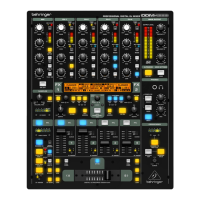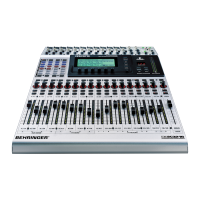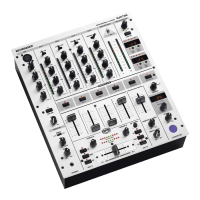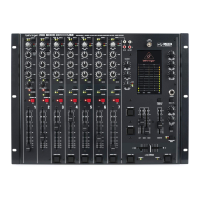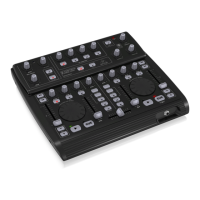47. Press SELECT/LOW to access the effects list (on the display). Turn and press the knob (45) to load a preset.
48. Press the PARAM/MID push button to access the effect parameters. Turn the knob (45) to change the
parameter value.
49. Press DEFAULT/HIGH to restore a preset.
50. Depending on the selected effect, the BEAT push buttons can adjust time related parameters. However, the
values entered are not in milliseconds or similar units, but in beats.
51. To enter the tempo manually, tap this push button (at least 2x) in the rhythm of the music (TAP). By keeping the
AUTO BPM/TAP push button pressed a little longer (> 1 s), the automatic tempo input (AUTO BPM) is
reactivated.
52. Turn the CONSOLE SETUP knob to adjust the tempo of the MIDI Clock (press and turn simultaneously =
coarse adjustment). A short press on the knob confirms the entry made. A long press on the knob lets you
access Console Setup.
53. The MIDI START/STOP/ESC turns on the MIDI Clock.
54. The ADJUST push buttons let you transfer the tempo of the BPM counter to the MIDI Clock.
55. Press the INSERT push button to add the sampler signal to the channel (Insert Mode). If the push button is not
activated, the sampler is mixed to the selected channel (Mix Mode). In both cases, playback is initiated with the
REC SOURCE push buttons. When the sampler is routed to the crossfader, the LED of the INSERT push
button goes out.
56. The VOLUME/MIX knob controls the volume of the sampler (in Mix Mode) as well as the volume balance
between input signal and Sampler (in Insert Mode).
57. The REC SOURCE push buttons let you select the channel for recording and playing back samples.
58. Press the PFL push button to listen in on the sampler signal with the headphones.
59. SAMPLE LENGTH adjusts the recording time (1–16 beats or endless recording ∞).
60. RECORD/IN lets you record to the Sampler. Select a bank beforehand. By pressing the push button a second
time, the recording is stopped (only in ∞ Mode).
61. BANK ASSIGN is used to select a bank in which the recorded material is stored. The selected bank is
indicated by the relevant MODE push button (61) which signalizes the readiness to record.
62. The MODE push buttons (Bank 1 and Bank 2) are used to select the sampler’s types of playback (Reverse and
Loop). A short tap activates or deactivates the Reverse function; pressing the push button a little longer
activates or deactivates the Loop function.
63. Press the PLAY/OUT push button to start the playback of the recorded sample. When the Loop function is
deactivated, the sample is only played back as long as the PLAY push button is pressed.
64. Press SMP FX ON push button to activate the Brake effect.
65. Press the SELECT push button to determine the length of the brake (1, 4 or 8 Beat Brake, which is shown in
the center of the display).
66. The CF ASSIGN push button lets you determine on which side of the crossfader the sampler signal is to be
routed to.
67. You can even trigger the sampler with the crossfader when the sampler is assigned to it. To order to do so,
simply press the CF START push button. But beforehand, use BANK ASSIGN to select the bank that should
be played back when using the fader.
68. The LINE inputs are used to connect the Line signals (for example, CD players, sound cards and drum
machines).
69. The PHONO inputs let you connect turntables.
70. Use the PHONO/LINE switches to set the PHONO inputs to Line level in order for you to be able to connect a
CD player to the PHONO inputs.
71. The GND connectors are used to ground the turntables.
72. The balanced XLR connectors provide a connection for dynamic microphones.
73. This is the LEVEL control for the MIC 2 input.
74. These are the OUT A outputs (XLR) allowing you to connect to an amplifier. Use the OUTPUT A control (30) to
adjust the volume level. Additionally, the SUBWOOFER output lets you hook up a subwoofer. A crossover is
integrated into the DDM4000. The crossover frequency is adjusted in Output Setup.
75. The MAIN OUT connector panel consists of OUT A, OUT B and TAPE outputs.
76. DIGITAL OUT is the digital output of the DDM4000. This is where you find the TAPE signal in CD quality (16
bit/44.1 kHz).
77. These are the MIDI IN, MIDI OUT and MIDI THRU connectors that allow you to connect external MIDI
equipment and synchronize with their MIDI Clock.
78. Power is supplied via an IEC connector. The matching cable is provided with the unit.
79. FUSE RETAINER/VOLTAGE SELECTOR.
80. Use the POWER switch to turn on the DDM4000. Before connecting the unit to the power mains, ensure that
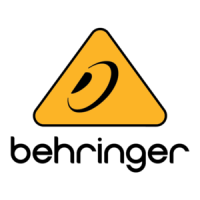
